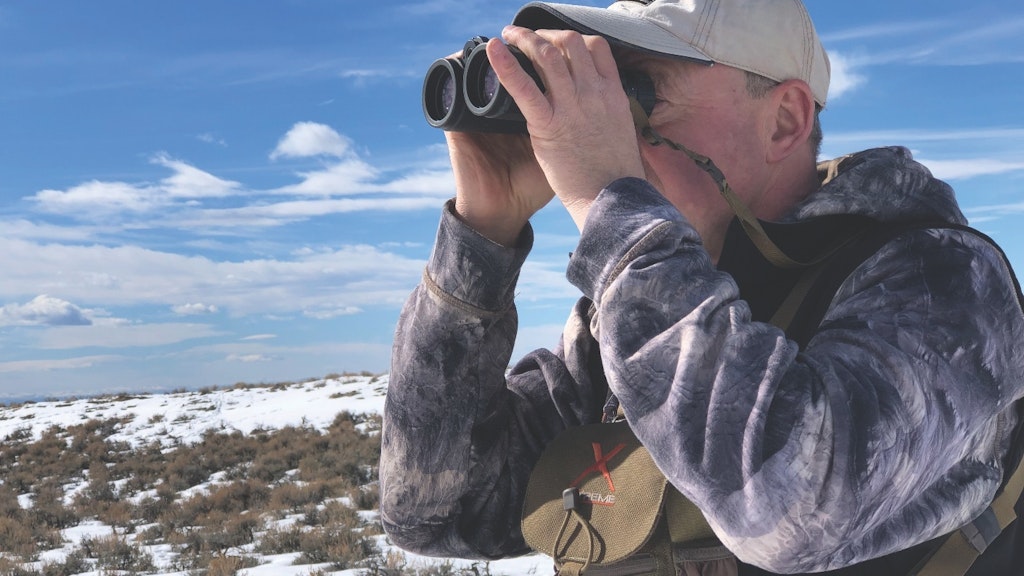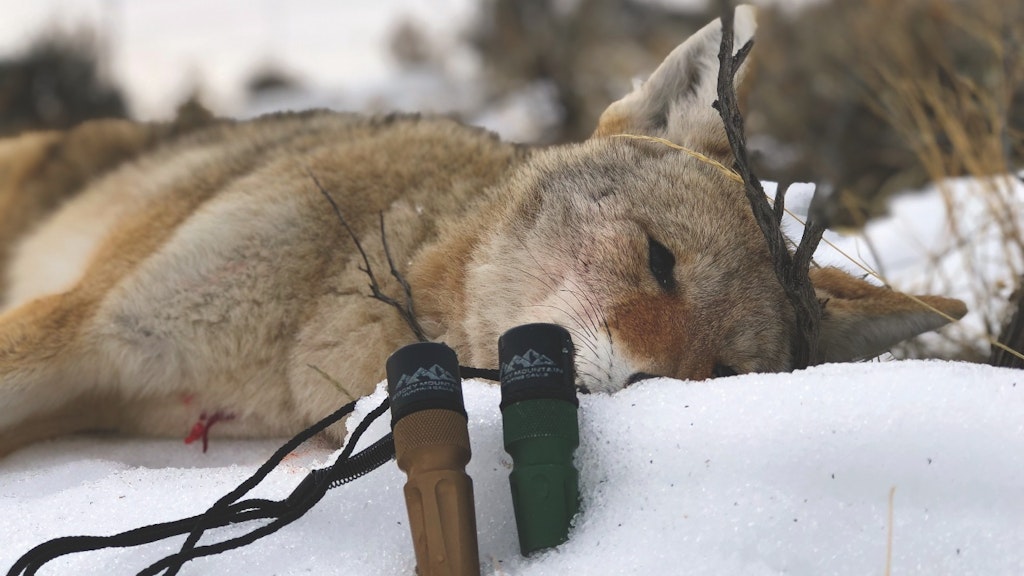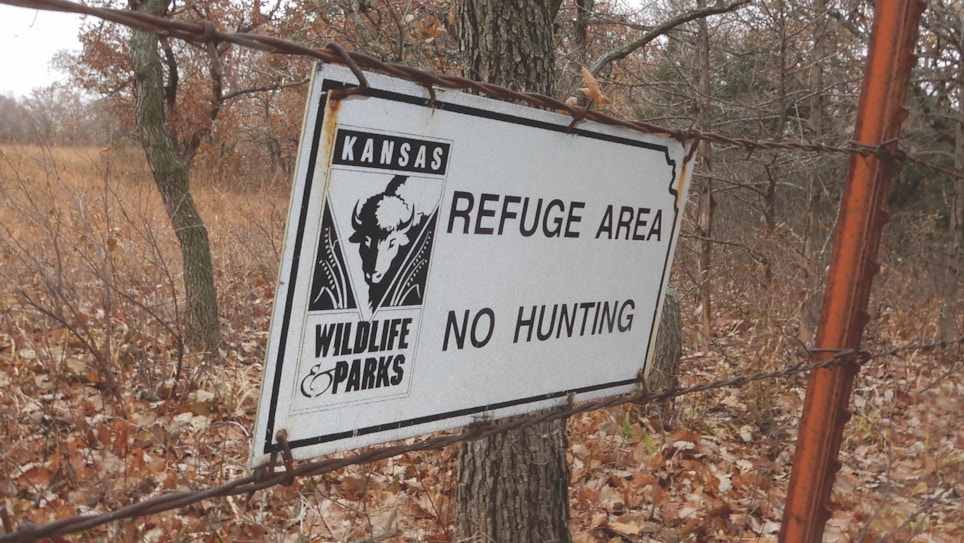“We’ll set up here,” my hunting partner whispered as we sneaked over a ridge overlooking a sweeping valley. It had the appearance of a coyote Costco store, with everything required for comfortable living. A handful of deer eyed us from below, and the brushy cover beyond that — likely stocked with birds, rabbits and rodents — told a tale of good calling ahead.
As I adjusted my auditorium-style seat, a distant fence that was signed with purpose prompted a question. “Isn’t that the park boundary out there?” My host nodded. “That’s why I set up here,” he said. “We’ll call coyotes from inside the park and probably from this property, too. But don’t take any long shots inside the fence. Let them cross before shooting.”
I nodded in agreement with a smirk on my face. Any gullible coyote living in that no-hunting refuge better think twice about ducking under the five-wire fence.
Since that early introduction to hunting the boundaries of good-looking non-accessible coyote properties, I have made it a mission to always be on the lookout for the next fence to set up along where I can hunt the adjacent parcel. I’m constantly on the lookout for these property gems where I can hatch a plan to hunt their unsuspecting canines with tactical resolve.
Property to Patrol
That property we hunted was actually adjacent to a national park where hunting within the perimeter is a huge no-no. The person who hosted me on that hunt and the name of the park will not be divulged, but the setup was legal on privately owned deeded property that abutted the park. Those types of tracts should top your list of places to look for. Any large expanse of land with a no-hunting designation has the tendency to hold a plethora of wildlife, including predators. Your job is to diligently search for such properties and adjacent, legal access.
Arm yourself with the best detective tools. A hardworking hunting app gives you that power right in the palm of your hand. I use HuntStand with the Pro Whitetail upgrade as my Sherlock Holmes helper. The upgrade opens a world of information using the Property Info feature that outlines borders and ownership details. Public and private information is neatly displayed on the screen, providing a satellite image of the target area and adjacent land. Begin with those areas that are obviously off limits: parks.
National, state, county and city parks often have no-hunting policies. By snooping around your ZIP code and reviewing each entity you might be able to find a winner. These refuge areas typically stand out, but sometimes public property has a questionable designation outside of a park title. Dive deeper and investigate government research facilities, military bases, training centers and even buffer zones around utility assets. Wildlife may use these non-tourist areas as additional sanctuaries. Standard wildlife refuges also might be closed to hunting along with wildlife designated habitat deemed essential for a threatened species. Dig deep. You never know what you will discover.
Next on the list is private properties with limited access or outright no-hunting rules. As America’s love affair with private wildlife management flourishes (think food plot craze), and large estates being purchased for investments, more and more gates are closed to hunters. That is the beauty of America, but it is also a beast when you lose a hunting property. Like a park or refuge, private properties that receive limited or no hunting pressure create a vacuum that sucks in all sorts of wildlife, prey and predators.
Finally, think of the obvious no-hunting areas. Cities and towns have definite boundaries for taxes and ordinance enforcement. Despite their busy nature, predators and prey alike find immunity within. Some of the best evidence of city-dwelling coyotes comes from the Cook County Coyote Project in Chicago which has acquired data since 2000. It demonstrates coyote resilience and the capability to live in the Windy City. If coyotes can thrive in Chicago, even with the frequent, non-targeted, weekend gunfire, they can reside in any city, anywhere.
Finding an off-limits property is easy. Finding access next door is the next hurdle. Here’s where you need to make that hunting app smoke. Begin by identifying public parcels next to either a public refuge or a private, no-hunting estate. This could be a national forest, Bureau of Land Management tract, state trust land or even county land. I hopscotch continually on these properties to gain access to the boundaries of private properties I have no chance of hunting. I do not get to hunt the private interiors, but hunting their boundaries opens acres of new country to call.
Next, knock on doors — and they do not need to open huge acres of property. A 20-acre farm provides plenty of coverage to a next-door property manicured for wildlife. Oftentimes, the owners of small properties are more willing to allow access because they do not have as much to protect for their own hunting. Some might not hunt at all, but relish country life while harboring no ill will to a courteous hunter who is targeting predators.

Zero-In on Property Personalities
As you scour land and consider knocking on doors, be on the lookout for the best in property personalities on the lands where you hope to lure coyotes from. Every swathe of property is not created equal. Some have the makeup of a desert while others give off that coyote Costco vibe. First, consider habitat. Coyotes thrive in a variety of environments, from beachside digs to the highest mountain peaks — from deserts to tundra. Regardless, the property must have some desirable qualities that attract coyotes. Think brush, overgrown thickets, dense woodlands, wetlands, tall-grass prairie and anything else that looks like it could house a boatload of prey species that attract coyotes.
In the same breath, properties that do not allow hunting, but also have distinct usage factors affecting habitat, might serve only as pass-through zones for coyotes. In the Midwest, a large, cleanly harvested soybean field has few characteristics that hold coyotes. The same goes for a large, open pasture that has been intensely grazed. Focusing on the perimeter of fields such as these could be wasted time unless you see a travel pattern in play.
Second, consider other inhabitants. With quality habitat comes quality wildlife populations in most instances. A property purchased mainly for escape, aesthetics and preservation with a no-hunting rule offers an ideal homeland for a variety of wildlife, adding limitless lunch specials for coyotes within. Coyotes dine primarily on rodents, but when opportunity knocks, they raid nests, hunt fawns, chase elk calves and even pack up to pursue big game. Refuge areas, public and private, that winter large masses of winter game are coyote magnets. Study these refuge borders for hunting possibilities. Nothing is off the table for coyotes if the opportunity to secure a meal includes a reduced risk of injury or death.
And all dining does not need to be wild. Closed areas where they can capitalize on the sheep, llama, hog, poultry or domestic waterfowl market also get a second look from local coyotes. Of course, coyotes prefer the small, unguarded species of livestock, but even large herds of cows and bands of horses receive attention from passing coyotes. Absentee landowners who close hunting often run livestock as a tax benefit to show a loss on their investment, thus reducing their tax burden. Even the rich are drawn back to agriculture to ease the pain of ownership.
Finally, consider size. It does matter. Depending on the region, coyotes might have a home range of 3 square miles or more. A small property could be a coyote conduit, but do not expect them to stake a homestead on a postage stamp size property. Typically, I look for a section of land or more before I focus on examining the border hunting choices.
During one outing, I stumbled across a hired hand fixing fence and queried him about hunting. He said the property was owned by an absentee landowner who did not allow hunting. I began a quick review on my HuntStand app of all surrounding owners and discovered a state parcel bordering the far side. While driving around the property to review the state access, I quickly lost interest. During the previous summer drought, the land manager had grazed the property down to dirt. Coyotes likely crossed the open country, but it was doubtful any lived there 24/7. Do your research.
Boundary Tactics
As you contemplate tactics for a border bounty of coyotes, the first rule is to hunt far away enough from the boundary to prevent any wounded coyotes from escaping back into protected territory. During my early days of coyote hunting, I unceasingly used the .22-250 Remington as my enforcement tool. Rarely did a coyote take two steps after eating a 55-grain V-Max. Then I switched to the new kid on the block, the .204 Ruger, and occasionally had a hardened criminal coyote run off carrying a bullet. The lesson learned is to use a big enough stick and stay far enough from a border to avoid escapees back to the safe zone. Usually, 100 to 200 yards is enough space, but you be the judge depending on your weapon of choice, terrain and the unfriendliness of the neighbors.
Next, study the boundaries and adjoining terrain. Look for areas that connect thick cover to the best hunting areas. Low valleys, coulees and the likes serve as concealed routes that allow coyotes to move invisibly between preferred habitats. Also, study the fence. Some properties might be lined with woven-style fences to prevent wildlife from leaving, including coyotes. Even a low-strung sheep fence could cause a coyote to travel along the barrier looking for gaps and low spots to easily cross. Mark these on your hunting app and look for setup sites nearby that give you a view of the gateway access point.
Next, include some loud calling in your routine. I typically begin on low or medium volume when kicking off a stand, but halfway through it does not hurt to increase the volume to call farther beyond the boundary. Climatic conditions alone, wind and rain, could dampen volume, but a loud finale could call a distant coyote. On a calm day you could easily call a coyote from a mile away.
Stay longer to meet up with those long-distance doggies. Territorial respect often affects if coyotes show up from extreme distances, but in rugged terrain it could easily take a coyote 30 minutes to cover a mile, especially if it is just responding out of curiosity. My main rule is to stay a minimum of 30 minutes and oftentimes in my Wyoming neighborhood, I wait an hour. Our coyotes are dispersed widely and cover large territories. The majority of my successful setups almost always surpass the 30-minute mark.
Lastly, set up adjacent to other wildlife and livestock in the area, but keep on your side of the fence. Coyotes often bed up close to their lunch target, particularly during those months when fur is prime. One season I hunted public lands on two sides of a private ranch. I always tried to locate the cattle first and then get as close to the herd as possible on the public parcels before calling. Response time was minimal because the coyotes often were napping close to the herd.
As for my national park hunt earlier, my buddy pulled out his hand call and screamed a message of pain across the opening below. Twenty-five minutes into the setup a coyote peeked over a ravine lip below and then disappeared. My friend whispered a curse and we both swiveled to the next expected showing.
Surprisingly, nothing showed and after a few minutes we decided the coyote had swapped ends and left. As we sat up to leave a coyote bolted behind us. My buddy went prone and barked the coyote to a permanent stop. Was it the same coyote? Who knows, but it was a prime coyote that crossed the wrong border for sure.

Reduce your rifle’s report without adding a lot of weight with a minimized suppressor from Silencer Central
Every year I inspect all my coyote gear to pare down weight to facilitate longer cross-country hunts. For this coming season, I am considering a suppressor upgrade with the Silencer Central Banish Backcountry. This minimized suppressor is designed with six baffles and tames a rifle shot down to 136dB. It easily mounts with 5/8x24 threaded ease and does not kill your overall predator rifle weight with its 7.8-ounce makeup. For those of you worried about ordering a suppressor and jumping through the hoops of federal bureaucracy, Silencer Central has streamlined the process with personalized service to make your journey into quiet hunting less painful. Check them out at www.silencercentral.com.
Hornady Superformance .223 Rem. 50-Grain CX copper bullets rule the day where lead is no longer an option
Copper may be your thing when it comes to bullets, but more than likely you are considering copper to be compliant in those states, such as California, that require non-lead ammo for hunting. Hornady understands the situation and has taken elements of its popular ELD-X bullet to create the CX, a copper alloy expanding bullet that meets most copper compliant regulations.
Grooves on the CX bullet maximize aerodynamics. This engineered design also reduces bearing surface and fouling. For predator hunting, consider Hornady’s Superformance line of ammunition with the new release of the .233 Rem. loaded with the 50-grain CX bullet. Hornady Superformance propellants are the heart of this latest offering and Hornady testing confirms a speedy muzzle velocity of 3,300 fps. For more information, visit www.hornady.com.






